Today I’ll show how we can make use of an excellent article written in 2+2 forums about finding leaks in our game with the aid of Poker Tracker. It is not necessary to read the article, since I’ll discuss each point separately here accompanied by my personal statistics. If you do have the application you can check your own stats in the end or you can simply see how a poker player can improve his skills by studying himself. My analysis will be based on the hands I played this year at 6-max No Limit poker tables (233,579 hands).
So, Pokey (the article’s author) starts with:
- Preflop Aggression
“Open up your ring game statistics and go to the “position stats” page. For each position other than the small blind, divide the “PF Raise %” by the “Vol. Put $ In Pot.” If you get a number smaller than 0.5, you’re not aggressive enough out of that position. See, aggression is a relative term; it should be a function of your level of looseness. You can be a consistently winning player at SSNL with a VPIP of 12%, and you can be a consistently winning player at SSNL with a VPIP of 30%, but only if you are sufficiently aggressive. My general guideline is that you should raise at least half the hands you play, from every position on the table.”

Upon checking the tab in my database, we can see that I’m quite aggressive at all positions but blinds where I still play by the rule, although my aggressiveness has decreased. That is expected though, since the Blinds’ positions offer no positional advantage to the player.
- Positional Awareness
“To test this, go to the Position Stats and look down the list of VPIP from Button to UTG. You should see that VPIP steadily dropping the farther you get from the button. I’d love to see my button VPIP at double my UTG VPIP, but if my Button VPIP is at least 50% larger than my UTG VPIP, I’m happy with the situation.”
From the previous image I am able to verify that my VPIP increases significantly towards the Button where the actual figure is more than double that of UTG’s one. No leak there.
- Stealing Blinds
“To check on your performance when trying a blind steal, go to the General Info. tab. Where it says “Att. To Steal Blinds” I’d like to see that number at LEAST 20%. (Personally, I like mine to be over 30%, but I’m very aggressive in these situations. If you’re trying to steal the blinds less than 20% of the time, you’re leaving lots of money on the table.)
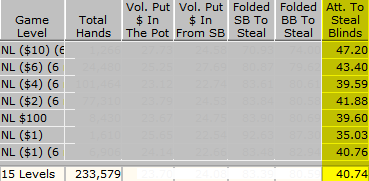
Now click on “Filters…” and under “Chance to Steal Blinds” click “Chance to Steal & Raised.” Select OK and look at the numbers. This shows every time you’ve tried to steal the blinds, and how the attempt turned out for you. Under “Totals” see the “BB/Hand” statistic. That shows your per-hand winrate on blind steals. If you multiply this number by 100, it should be at least double your “PTBB/100″ average winrate. If it’s much less than that and you have a decent sample size, you have a hole in your game when it comes to blind stealing. This should be an exceedingly profitable thing to do when you try it; if it’s not, you need to work on your strategy.”
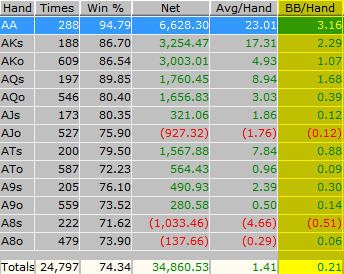
No apparent leaks are found here either. My Att. To Steal Blinds is over 40% (maybe I overdo it?) while my total BB/Hand multiplied by 100 (=21) is almost 20 times more than my actual BB/100 (1.27).
- Defending blinds
“Click on “Turn Filter Off,” and then click on “Filters…” again. Under “Blind Status” click on “Either Blind.” Now under “Vol. Put $ In Pot” click on “Put Money In.” This shows you if you’re bleeding money out of the blinds. A “BB/Hand” of about -0.375 would indicate that you were no better off putting money into the pot than if you had folded. If your “BB/Hand” is larger than that, then you typically win back some of your blind money when you put money into the pot from the blinds. That’s all you can really hope for.
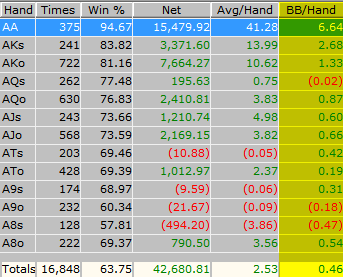
If you click on “Filters…” again and go under “Steal Attempted Against Your Blind” and click on “Steal Attempted.” After you click “OK” you’ll now see how you did when you chose to defend against a blind steal. Again, the magic number is for your “BB/Hand” to be bigger than -0.375; that means you’re making back some of your blinds when you try to defend against a steal. If either of these numbers is lower than -0.375, you’d lose less money by always folding rather than doing what you’re doing.”
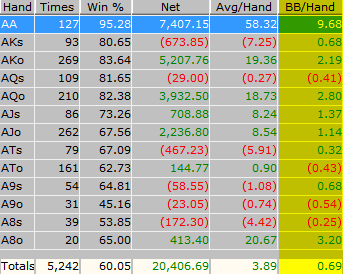
Now, that doesn’t look a leak to me, does it? While I am defending my blinds against stealers, I actually manage to show significant profits!
- Heads-Up Play
“Click on “Turn Filter Off,” then click on “Filters…” again. Under “Hands With Between…Players Seeing The Flop” change the range from “0 to 10 players” to “2 to 2 players.” Hit “OK” and see what comes up. This shows you how you’ve done when you were heads-up preflop, but a flop was dealt. See how you’ve done in these situations.
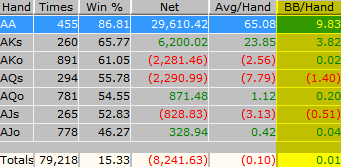
If things look OK, go back to “Filters…” and under “Pre-flop Raise” select “No Raise.” This will show you how you’ve done when you didn’t raise preflop, but the hand was heads-up on the flop (this includes pure limping and when someone ELSE raised preflop, but not when you were the preflop raiser). Is this number positive? If not, it could be an indicator that you have trouble when you are not the aggressor preflop, especially without padding in the pot.”
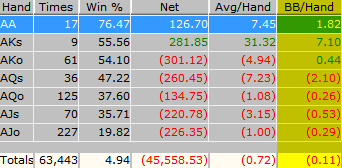
Houston, we have a problem. Both images show mediocre results and the heads-up play is something I should focus on.
- Multiway Pots
“Clear the filter and go back under filters. Change “Hands With Between…Players Seeing The Flop” to “3 to 10 players.” This shows you how you do in multiway pots.
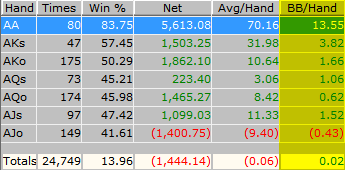
If things look good, go back and select “No Raise” under “Pre-flop Raise.” Is it still positive? If so, you’re selecting good times to play/limp multiway pots, and you’re playing them well postflop.”
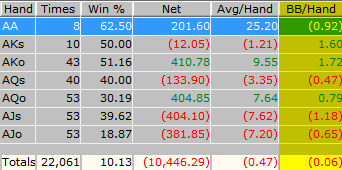
Hmmm, I can’t say I’m doing well in multiway pots either. My postflop game really needs improvement.
- Pocket pairs
“Under “Filters…” change the “Type of Hole Cards” to “Pairs.” This will show you how you generally play and perform with pocket pairs. Your Total VPIP with these should be EXTREMELY high; unless you play at highly unusual tables, I’d be surprised to see this number below 85%. Pocket pairs make extremely powerful hands that are extremely well-hidden; if you’re not playing them almost all the time, you’re leaving money on the table. Also, your Total PFR% with these hands should be rather high — at least 1/3 of your VPIP, if not 1/2. Some people have this number higher still, and I don’t have a problem with that, especially at short-handed tables. If you have enough hands, I’d expect every one of these lines to be positive, and reasonably significantly so. If you have any glaringly negative numbers, especially AA-88, it may indicate bad play. Look over individual hands where you lose lots of money and see if you played too timidly early in the hand, or if you went too far unimproved in the face of resistance. Also, look at the hands where you won to see if you played too timidly, or if you routinely forced weaker hands out when you should have been milking them for profits.
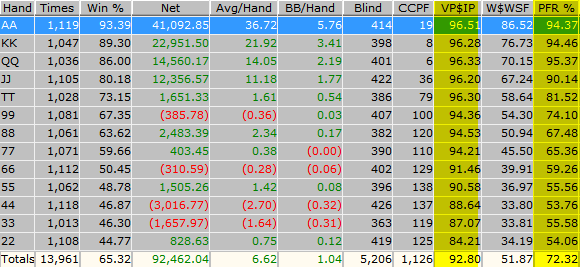
I guess I should take a closer look at 88-TT’s hands for any leaks.
- Suited Connectors
“Under “Filters…” change “Type of Hole Cards” to “Suited Connectors.” I’m much less likely to play suited connectors than pocket pairs, but some people play them religiously. As a result, I don’t really have a good suggestion as to how high your VPIP or PFR should be. However, your BB/hand should be positive; if it’s not, you’re probably not playing your suited connectors well. Remember: these hands play best in a multiway, unraised pot, or as a steal move.
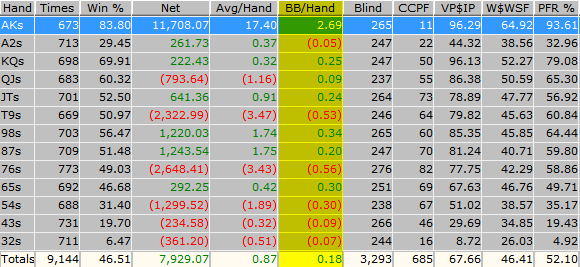
In the “Filters…” change “Vol. Put $ In Pot” to “Cold-Called.” When you hit OK, you should have almost no entries to view. Of the times you cold-called, you should be able to come up with a specific explanation for why you did so in each and every one of them. Review the hand histories; if you can’t come up with a really good reason why you thought it better to cold-call, rather than raise or fold, you need to rethink your suited connector strategy. Good explanations: the raise was very small, villain is passive post-flop, I had position on villain, villain and I are both extremely deep-stacked, villain is incredibly aggressive preflop, my suited connectors are particularly strong, there are several cold-callers in front of me, etc. I’m not saying you shouldn’t ever cold-call with suited connectors; rather, I’m saying you shouldn’t AUTOMATICALLY do so. Your default play here should be to fold weak suited connectors and reraise strong ones.”
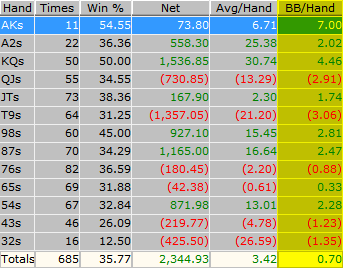
I’m able to show positive numbers in both situations although I’m not entirely happy with the result. Perhaps if someone could share his own numbers as a comment, we could have a better idea of where I stand.
- Unsuited Connectors
“Clear the filter and then go back into it. Change “Type of Hole Cards” to “Off-Suited Connectors.” Your VPIP for these hands should be noticeably smaller than your VPIP for suited connectors. Check your winrate and make sure it’s positive.
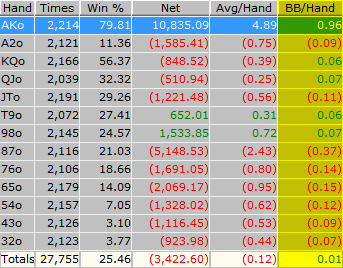
Filter for cold-calling and see if you had good reasons for doing so, keeping in mind that the reasons need to be even stronger than for suited connectors.”
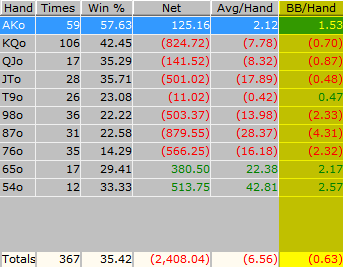
While I’m breaking even at the first scenario, I’m losing money when I’m cold calling my off suit connectors. Guess I won’t be doing that any more. I’ll save 0.63BB per hand by doing so!
- Postflop Aggression
“Select the “More Detail…” button above the “Filters…” button. Scroll down. There is a section marked “First Action on Flop After A Pre-flop Raise.” This shows your likelihood of continuation betting. If you add Bet and Raise, the total should be at least 40%. If it’s not, you’re probably giving up too soon on your good hands, and that will cost you money in the long run. Remember: people who cold-call a preflop bet are often in fit-or-fold mode. If you don’t bet, you don’t give them a chance to fold. The pot is already decent-sized, and there’s no reason to give some donk a free look at a turn card that could sink you. If you raised preflop, you need a good reason NOT to raise the flop. Continuation betting should be your default play. Scroll down a bit farther to “Aggression Factor.” Your total aggression factor should be at LEAST 2. No-limit is not a game where you can call frequently and turn a profit. You should always be looking to see if you can raise or fold; only if you have a good reason why you CANNOT raise or fold should you call. As a result, calling should be an infrequent occurrence in your play, which gives you a large aggression factor.”

I’m continuation betting about 68% and my total Aggression Factor is 3.90.
- Check-raising
“Some people never check-raise; others check-raise infrequently. I personally like to check-raise at least once in awhile; 1% would be fine, 0.5% would be acceptable. The goal of the check-raise is to remind your opponents that just because you checked does NOT mean that you don’t have a hand. However, circumstances need to be very specific for a check-raise to be appropriate. Typically, I check-raise on the flop when OOP against a preflop raiser, or on the turn when OOP against a flop bettor/raiser who was clearly not on a draw (uncoordinated flop). If you are check raising much more than 2% of the time, you’re being entirely too tricky for a SSNL table, and straightforward play would probably be more profitable for you.”
The previous image shows that I’m check raising about 1%.
That completes my first analysis of my poker play. You can do your analysis on your own statistics if you happen to use Poker Tracker. If you don’t, Poker Tracker version 3.0 has just been launched and is offered with a trial period of 60 days.






